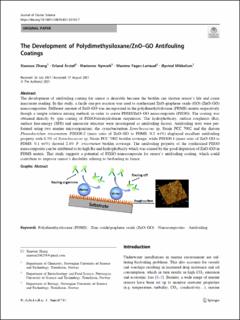| dc.contributor.author | Zhang, Xiaoxue | |
| dc.contributor.author | Årstøl, Erland | |
| dc.contributor.author | Nymark, Marianne | |
| dc.contributor.author | Fages-Lartaud, Maxime René | |
| dc.contributor.author | Mikkelsen, Øyvind | |
| dc.date.accessioned | 2021-09-16T09:08:41Z | |
| dc.date.available | 2021-09-16T09:08:41Z | |
| dc.date.created | 2021-09-06T11:50:24Z | |
| dc.date.issued | 2021 | |
| dc.identifier.citation | Journal of cluster science. 2021, . | en_US |
| dc.identifier.issn | 1040-7278 | |
| dc.identifier.uri | https://hdl.handle.net/11250/2778515 | |
| dc.description.abstract | The development of antifouling coating for sensor is desirable because the biofilm can shorten sensor’s life and cause inaccurate reading. In this study, a facile one-pot reaction was used to synthesized ZnO–graphene oxide (GO) (ZnO–GO) nanocomposites. Different amount of ZnO–GO was incorporated in the polydimethylsiloxane (PDMS) matrix respectively though a simple solution mixing method, in order to create PDMS/ZnO–GO nanocomposite (PZGO). The coating was obtained directly by spin coating of PZGO/tetrahydrofuran suspension. The hydrophobicity, surface roughness (Ra), surface free-energy (SFE) and nanoscale structure were investigated as antifouling factors. Antifouling tests were performed using two marine microorganisms, the cyanobacterium Synechococcus sp. Strain PCC 7002 and the diatom Phaeodactylum tricornutum. PZGO0.2 (mass ratio of ZnO–GO to PDMS: 0.2 wt%) displayed excellent antifouling property with 8.5% of Synechococcus sp. Strain PCC 7002 biofilm coverage, while PZGO0.1 (mass ratio of ZnO–GO to PDMS: 0.1 wt%) showed 2.4% P. tricornutum biofilm coverage. The antifouling property of the synthesized PZGO nanocomposite can be attributed to its high Ra and hydrophobicity which was caused by the good dispersion of ZnO–GO in PDMS matrix. This study suggests a potential of PZGO nanocomposite for sensor’s antifouling coating, which could contribute to improve sensor’s durability relating to biofouling in future. | en_US |
| dc.language.iso | eng | en_US |
| dc.publisher | Springer Nature | en_US |
| dc.rights | Navngivelse 4.0 Internasjonal | * |
| dc.rights.uri | http://creativecommons.org/licenses/by/4.0/deed.no | * |
| dc.title | The Development of Polydimethysiloxane/ZnO–GO Antifouling Coatings | en_US |
| dc.type | Peer reviewed | en_US |
| dc.type | Journal article | en_US |
| dc.description.version | publishedVersion | en_US |
| dc.source.journal | Journal of cluster science | en_US |
| dc.identifier.doi | https://doi.org/10.1007/s10876-021-02165-7 | |
| dc.identifier.cristin | 1931562 | |
| dc.description.localcode | This article is licensed under a Creative Commons Attribution 4.0 International License, which permits use, sharing, adaptation, distribution and reproduction in any medium or format, as long as you give appropriate credit to the original author(s) and the source, provide a link to the Creative Commons licence, and indicate if changes were made. The images or other third party material in this article are included in the article's Creative Commons licence, unless indicated otherwise in a credit line to the material. If material is not included in the article's Creative Commons licence and your intended use is not permitted by statutory regulation or exceeds the permitted use, you will need to obtain permission directly from the copyright holder. To view a copy of this licence, visit http://creativecommons.org/licenses/by/4.0/. | en_US |
| cristin.ispublished | true | |
| cristin.fulltext | original | |
| cristin.qualitycode | 1 | |

